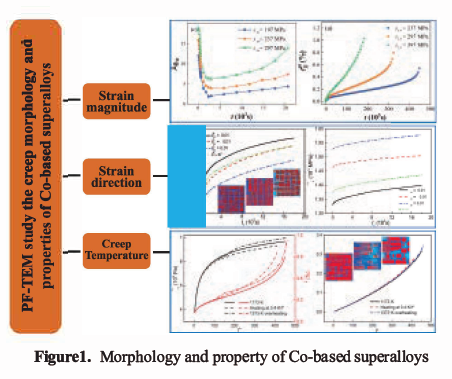Yongsheng Li*, Shujing Shi, Yinfei Ju, Peng Sang, Zan Zhang
1Nanjing University of Science and Technology, School of Materials Science and Engineering,Nanjing, 210094, China
2MIIT Key Laboratory of Advanced Metallic and Intermetallic Materials Technology,Nanjing, 210094, China
EXTENDED ABSTRACT: The morphology evolution and deformation behavior of the Ll2-'strengthening Co-based superalloys under complex thermal-mechanical effects are important theoretical basis for creep damage mechanism and property optimization. The crystal plasticity phase-field (PF) modeling is performed by coupling the sublattice free energy and creep damage theory to study the morphology and mechanical property of Co-Al-WN alloy under high temperature and stress. The PF-TEM coupling morphology evolution is developed. The effects of strain energy and diffusion potential in the formation of γ'rafting is revealed by the element diffusion. The mechanical of rafting evolution, and the relations among stress state, microstructural stability and γ'volume fraction are investigated from the critical resolved shear stress and shear strain on the slip systems activated by orientation stress, and the relationships between creep strain, creep resistance and orientation of γ'phases are clarified through γ'dissolution and directional coarsening under overheating loading. The elastic strain energy induces the difference of diffusion potential in horizontal and vertical y channels and promotes the formation of γ'rafts. The rafting evolution is accelerated under high stress, while the creep life decreases accordingly. The γ' volume fraction and orientation degree under compression stress are the largest, which inhibit dislocation movement further, improve the microstructure stability and creep resistance effectively, the γ'volume fraction under normal stress is higher than that under shear and monoclinic stresses, and the creep resistance increases in the order of tension, compression and shear loading. When γ'phases undergo overheating dissolution, the creep strain jumps and the creep resistance declines, the temperature regresses after overheating, hence the recovered γ'rafts compensate for the creep damage to a large extent. The results provide reference for the design, optimization and regulation of morphology and properties of precipitation-strengthened Co-based superalloys, and accelerate the development and application of alloy.
Keywords: Co-based superalloy; Crystal plasticity; Rafting; Slip shear; Dissolution


Yongsheng Li, professor, doctoral supervisor. He graduated from Northwestern Polytechnical University in 2007, worked as a postdoctoral fellow in Hong Kong University of Science and Technology from 2008 to 2009, and has worked in the School of Materials Science and Engineering of Nanjing University of Science and Technology since 2009. He work in field of phase transformation and relationship between microstructure and properties of superalloys, radiation damage and crystal defects, phase-field simulation and design of material microstructures. He has published more than 90 academic papers in journals, such as, Materials Science and Engineering A, Journal of Materials Science and Technology, Materials & Design, etc. He presided over 10 national, provincial and ministerial science and technology projects. He also possesses 4 authorized national invention patents, and 6 science and technology awards, including 2 first prizes of Jiangsu Science and Technology Awards. In addition, he works as reviewer of more than ten journals.